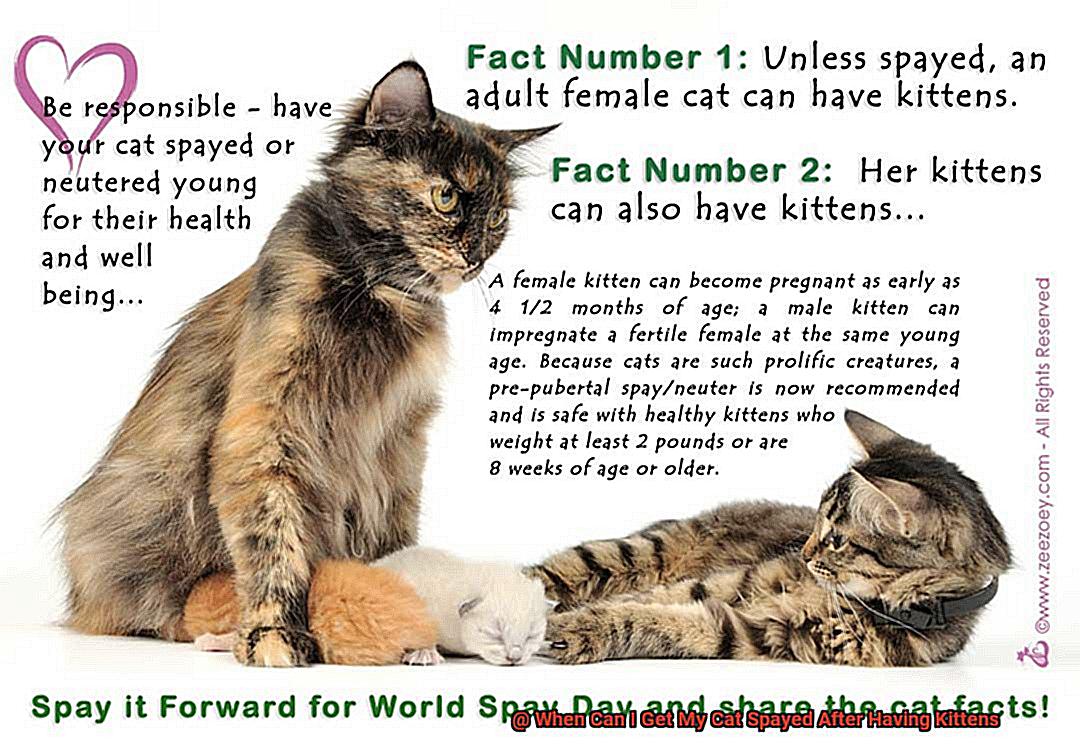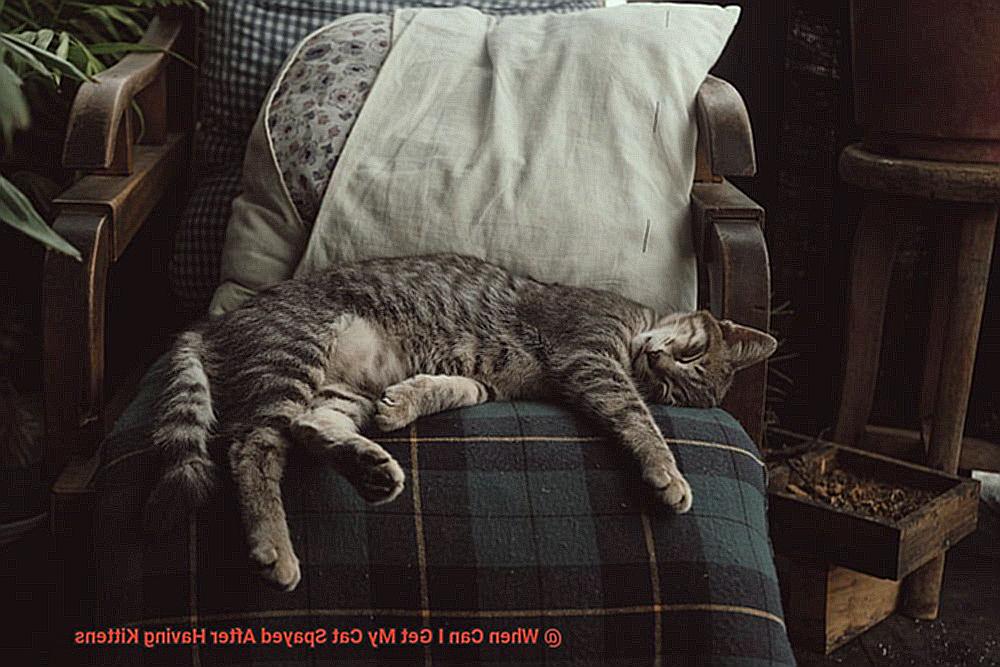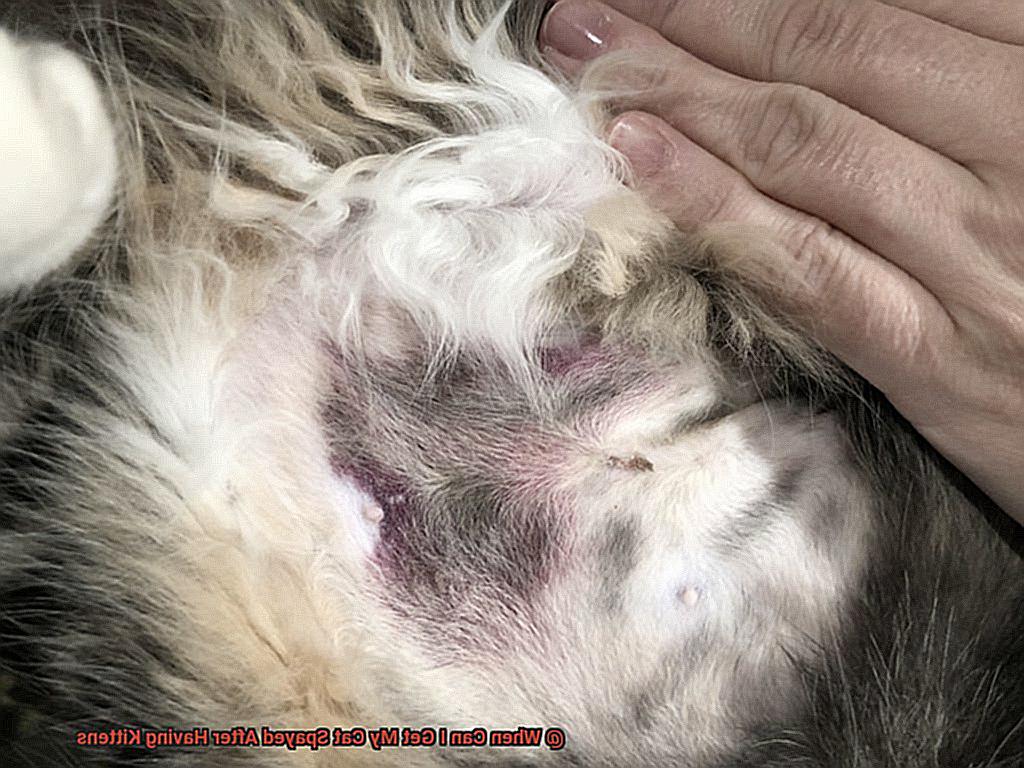Caring for cats is a big responsibility, and one of the most important decisions a pet parent must make is when to spay their cat after having kittens. But when is the right time?
Here, we’ll explore the benefits of spaying your cat after giving birth and provide some tips on how to tell when it’s safe and appropriate to do so. We will also discuss the dangers involved with waiting too long or getting your cat spayed too soon.

Spaying your kitten after having kittens has many benefits. Not only does it prevent unwanted pregnancy, but it can also reduce the risk of certain diseases and health conditions such as mammary tumors and uterine infections. It can even help reduce aggression in cats, making them more docile and loving companions.
However, there are risks associated with waiting too long or doing it too soon. To ensure that you make the right decision for both you and your pet, it’s important to understand these risks before taking any action.
In this blog post, we’ll take a closer look at when will I get my cat spayed after having kittens by looking at the benefits as well as potential risks of waiting or acting too quickly.
By understanding these variables better, you can make an informed decision about when is best for your particular situation.
What is Spaying?
Spaying your cat is not only a responsible decision to help avoid unplanned pregnancies, but it can also provide numerous health benefits for your furry family member. But when is the best time to spay a cat if she has had kittens?
To ensure the safety and well-being of both the mother and her children, it’s essential to consult with a veterinarian to determine the correct timing of the procedure.
Spaying involves the removal of a female cat’s reproductive organs, such as the uterus and ovaries. This common procedure not only helps control population growth but also reduces the risk of unwanted pregnancy and various health conditions, such as uterine infections and certain types of cancers.
The optimal age for spaying cats is typically between four and six months old. However, in some cases, it may be done on older cats as well. The timing of the surgery may vary depending on your cat’s overall health and whether or not she has previously given birth.

If your cat has recently had kittens, it’s important to wait until they are weaned and independent enough to survive without their mother’s milk and care – usually around 8 to 12 weeks old.

At this point, her milk production will have slowed down enough so that there is minimal risk of complications during surgery or post-operative recovery.
Benefits of Spaying After Having Kittens
For cat owners, spaying your furry family member after having kittens can be a beneficial decision. Not only does it help prevent unwanted litters, but it also reduces the risk of reproductive diseases and improves behavioral habits.
When considering spaying your cat after giving birth, timing is key. Most veterinarians recommend waiting 8 to 12 weeks for the kittens to become more self-sufficient and the mother’s milk production to slow down. This helps minimize any risks during surgery and recovery.
However, this timeline can vary depending on the mother’s health, size, and her litter’s wellbeing as well as availability of veterinary services – so make sure you consult with your doctor to determine when is the best time for spaying your cat after having kittens.
Spaying offers multiple perks for both cats and their owners. It helps prevent future pregnancies which can have health risks for both the mother and her litters.
In addition, it helps reduce the risk of reproductive diseases such as pyometra, a life-threatening uterus infection. Plus, spaying can help calm down cats during heat cycles by reducing their restlessness and aggressiveness.
When is the Best Time to Spay a Cat After Having Kittens?
When it comes to spaying a cat after having kittens, timing is key. The best time to spay will depend on the individual cat’s age and health, as well as the number of kittens she had and whether or not she is still nursing them.
Generally speaking, veterinarians suggest spaying before the mother cat goes back into heat, which can happen as soon as three weeks after giving birth. If the mother is still nursing her kittens, it is best to wait until they are weaned and have been placed in new homes – usually around ten to twelve weeks old.
However, if there were complications during delivery or if the mother cat has any existing health problems, it may be necessary to wait a bit longer before spaying. In such cases, consulting with your veterinarian about the best course of action is essential. Your vet will assess your cat’s overall wellbeing and provide a definite timeline for when the procedure should occur.
Factors that Influence the Timing of the Surgery
When it comes to spaying a cat after giving birth, timing is key. Responsible pet parents should wait until their cat has fully recovered from the birthing process and her kittens have been weaned before scheduling the surgery. But when exactly is the right time? This can vary depending on several factors that influence the timing of the procedure.
Age and health are two primary considerations when deciding when to spay your cat. If she has had a large litter or any delivery difficulties, it will take longer for her kittens to wean, so you may need to postpone the surgery until she is fully recovered and her children are able to survive without assistance from their mother. Conversely, if your cat has had a small litter or gave birth to just one kitten, it could be possible to schedule the surgery earlier.
The living situation of your feline friend can also play an important role in determining when it’s best to spay her. Indoor cats may not need to be spayed as soon as outdoor cats.
However, if your kitty spends time outdoors, she will be exposed to greater risks and you may need to consider spaying her sooner in order to prevent any unwanted pregnancies.
Risks Associated with Early Spaying
When it comes to caring for your feline family, spaying your cat after she gives birth to kittens is an important step that can help prevent future unplanned pregnancies and health problems. However, timing the spay surgery correctly is essential for ensuring the safety and well-being of both the mother and her offspring.
It’s recommended to wait until the kittens are weaned and stable enough to survive without their mother’s milk and care before scheduling a spay surgery.
This is typically when they are 8 to 12 weeks old. However, consulting with your veterinarian is the best way to determine the right time for the procedure, as there may be other factors that need to be taken into account such as the mother’s health, litter size and health, as well as availability of veterinary services.
Although spaying your cat will result in many health benefits, it’s important to be aware of potential risks associated with early spaying (before six months).
Such risks include an increased risk of urinary tract disease, obesity, some forms of cancer, and reproductive system development issues which may lead to complications during pregnancy or childbirth.
How to Prepare Your Cat for the Procedure
Preparing your cat for spaying surgery is an important part of the process, and it can make a big difference in the outcome.
Spaying your cat is a responsible move that can help her prevent health problems and unplanned pregnancies, but it’s essential to properly prepare her for the procedure. Here are five simple steps you can take to ensure that your feline friend has a safe and successful spay.
- First, it’s best to schedule the surgery when your cat is not in heat or pregnant. This will help eliminate any complications and give her plenty of time to recover afterward. Additionally, it’s important to inform the veterinarian of any medications or health issues your cat is currently experiencing. You may need to stop certain medications a few days before the surgery, as they can interfere with blood clotting, and the veterinarian may want to run some routine blood tests to ensure your cat is healthy enough for the procedure.
- Second, provide a quiet, comfortable place for your cat during recovery after the surgery. Keep her away from loud noises or other pets, and make sure she has plenty of soft bedding and a warm environment. This will make her feel more at ease as she recovers from anesthesia and minimize any post-operative anxiety.
- Third, hydrate your cat before the procedure by fasting for eight to twelve hours prior to bringing her in for surgery. This will help reduce any risks associated with anesthesia and ensure that she is fit for surgery. Your veterinarian will give specific instructions on how to stop feeding your cats before bringing them in for the procedure; be sure to follow these directions carefully.
- Fourth, keep an eye on your cat during recovery and watch incision sites for signs of infection or complications. The veterinarian may have specific recommendations on administering drugs or providing a soft diet during recovery; following these instructions closely will help speed up healing time and minimize discomfort.
- Finally, be patient with your feline friend during her recovery period—spaying surgery can be traumatic for cats so it’s important that they have lots of love and support during this time.
Aftercare Tips for Your Cat Following the Surgery
Spaying your cat is a responsible decision that can help prevent future unplanned pregnancies and health problems. However, the most important part of the procedure comes after the surgery – proper aftercare. Here are five tips to ensure that your cat has a quick and comfortable recovery following spaying surgery.
Monitor your cat’s behavior
After surgery, your cat may be groggy and disoriented, so it’s essential to keep an eye on her behavior and appetite to make sure she is recovering well. If you notice any changes in her behavior or appetite, contact your vet immediately.
Limit physical activity
Your cat should not engage in any strenuous physical activity such as jumping, running, or climbing for at least 10 days following the surgery. You can restrict your cat’s movements by keeping her indoors and providing her with a quiet, comfortable environment to rest in.
Keep the surgical site clean
To prevent infection, it is important to keep the surgical site clean and dry. You should avoid touching or rubbing the site and should not allow your cat to lick or scratch it. If the site becomes red, swollen, or infected, contact your vet right away.
Administer medication as prescribed
Your vet may prescribe pain medication or antibiotics to help manage any discomfort or prevent infection. It is essential to administer medication as prescribed and complete the full course of medication as directed by your veterinarian.
Follow up with your vet
Your cat will need a follow-up appointment with your vet to ensure she is recovering well and remove any stitches if necessary. It is important to attend all follow-up appointments and contact your vet if you have any concerns about your cat’s health during her recovery period.
Alternatives to Spaying Your Cat After Having Kittens
Making the responsible decision to spay your cat after having kittens is essential in preventing future unplanned litters and health issues. However, there are times when this isn’t possible or recommended right away. If you find yourself in this situation, there are alternatives to consider.
One option is to wait until the kittens are weaned, which usually happens around 8-12 weeks old. This ensures that the mother’s hormones have stabilized and that the kittens are no longer dependent on her milk.
Alternatively, hormone injections may be used to temporarily suspend your cat’s heat cycle for up to six months, allowing you more time to wait until the kittens are older or until it’s safe to spay your cat. However, bear in mind that hormone injections are not a long-term solution and may come with side effects such as weight gain, diabetes, and uterine infections.
Ultimately, it’s best to consult with your veterinarian about the best course of action for spaying your cat after having kittens. They will be able to provide personalized advice based on your pet’s health and circumstances.
Conclusion
Spaying your cat after having kittens is a critical move that can help ensure the health and safety of both your pet and her offspring. To make an informed decision about which is best for your particular situation, it’s important to understand the benefits, risks, and timing of spaying.
Generally speaking, it’s usually best to wait until the kittens are weaned and independent enough to survive without their mother’s milk and care. However, this timeline can change based on the mother’s health, size, litter size, living situation, and availability of veterinary services.
When preparing for surgery, schedule it when your cat isn’t in heat or pregnant; notify your veterinarian of any current medications or health problems; provide a warm bed and quiet environment during recovery; fast her for eight to twelve hours ahead; hydrate her before the procedure; keep an eye on her during recovery; watch incision sites for signs of infection or complications; administer medications as directed by your doctor; and be patient with her during the recovery period – spaying surgery can be traumatic for cats.
By knowing the risks involved with early spaying as well as alternatives such as hormone injections or waiting until kittens are weaned, you will be able to make an informed decision about when is best for you and your furry family member.







